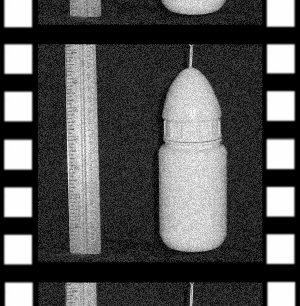In the early 1960s, around the time of the Cuban Missile Crisis, the Cold War between the communist bloc and the West was at its hottest.
The best Soviet undercover high-tech spy, known to US Military Intelligence only as Crazy Ivan, had successfully filmed a US thermonuclear detonation and had stolen blueprints for one of the critical components of the device. As he was leaving the nuclear test site with his movie camera, he was spotted by security forces and had to run. Unable to return to his safe house in Albuquerque, he fled to Houston, where he knew an undercover colleague who specialized in oil and gas technology espionage was operating. Unfortunately for Crazy Ivan, when he reached his colleague's base in the northern suburbs of Houston, he found that his colleague had been evacuated back to the USSR due to the high East-West tensions of the time. He was alone and out of contact with his people.
Desperate to deliver his hard-won intelligence data to the Soviet nuclear weapons researchers, he devised a radio code that his organization would recognize as a call for help.
The US security forces tracking Crazy Ivan intercepted his transmission and by triangulation narrowed down the transmitter location to the area between N30 to N32 and W94 to W96, but the transmission ended before they could refine the triangulation fix. They were able to record the signal, which sounded like the Cyrillic version of Morse Code on a scratchy record. The message itself looked like coordinates. In Roman characters, this was the message:
CJ JC.JFA N. AB DG.GJH W.
The message repeated over and over, but the Security officers had only a few clues about how to translate the letters into numbers. From their triangulation, they were pretty sure that A = 9 and C = 3. They knew that J could only be 0, 1, or 2 and that B could only be 4, 5 ,or 6. Logically, D could not be more than 5.
They got this far using what they knew:
CJ JC.JFA N. AB DG.GJH W.
3- -3.--9 N. 9- --.--- W.
Beyond that, the security officers were stumped.
Intent on capturing Crazy Ivan before he passed on his dangerous information, the Security officers sent the recording to their Cryptology section in Washington. After their initial playback of the recording, the junior cryptologist told his supervisor "This is a terrible recording. The Morse signal tone is awfully noisy". The senior cryptologist heard this comment and had a flash of intuition. "The key to the code is in the noise!" he shouted.
Together, the cryptologists set up a computer program that deconvolved the Morse signal tone into its sinusoidal components. To their astonishment, they found that the periods of the sine waves were all integer multiples of 1 millisecond and that the amplitude of each sine wave was an integer multiple of a base unit amplitude (the signal was recorded at an arbitrary distance from the transmitter, so the original amplitude of the signal was not known, but the relative strengths of the sine waves were all multiples of a unit signal strength).
When they examined the deconvolution results, they saw that the sine wave with the lowest amplitude (lowest letter in the alphabet is A) had a period of 9 milliseconds (A=9), the sine wave with the third-lowest amplitude (third letter in the alphabet is C) had a period of 3 milliseconds (C=3), and the sine wave with the tenth-lowest amplitude (tenth letter in the alphabet is J) had a period of 10 milliseconds (J=0 ...apparently, it was the last digit in the period that was used in Ivan's code). The cryptographers set up the following table:
Amplitude | Period | Ivan's Code
-----------------------------------
Lowest | 9 ms | A = 9
2nd Lowest | - ms | B = ?
3rd Lowest | 3 ms | C = 3
4th Lowest | _ ms | D = ?
5th Lowest | _ ms | E = ?
6th Lowest | _ ms | F = ?
7th Lowest | _ ms | G = ?
8th Lowest | _ ms | H = ?
9th Lowest | _ ms | I = ?
Highest | 10 ms | J = 0
(apparently, it was the last digit in the period that was used in Ivan's code)
They filled in the table according to the relative amplitudes of the various sine wave periods, plugged the numbers into the coordinates, and rushed to the location. They found Crazy Ivan camped in the woods and arrested him, along with his dangerous nuclear intelligence data. They brought in his radio transmitter but left the steel pipe that he used for his antenna.

But when they developed his movie film, they found some footage of this scale model of a US missile payload. They returned to the site of Crazy Ivan's capture and searched for the missile model, but could not locate his hidden cache.
Can you decode Crazy Ivan's message, find the location of Crazy Ivan's last campsite, and locate the hidden missile model? The User Web Site (up near the cache name) contains a digital file containing 86 milliseconds of Crazy Ivan's rescue call transmission at a 1/4 millisecond sample rate in Excel spreadsheet format. Be sure to SAVE the file rather than OPEN it with your Internet Browser, since you need to be running Excel to operate it correctly. The wave form equations are already entered on the "Partial Solution" worksheet, along with the 3 known digits and their amplitudes.
Approach the problem like the Washington cryptologists did. Deconvolve the signal into its sine wave components (periods of integer milliseconds between 1 and 10) and arrange them by increasing amplitude. The waves have no phase offset (they all start with zero values at the first sample). Remember that the amplitudes are integer multiples.